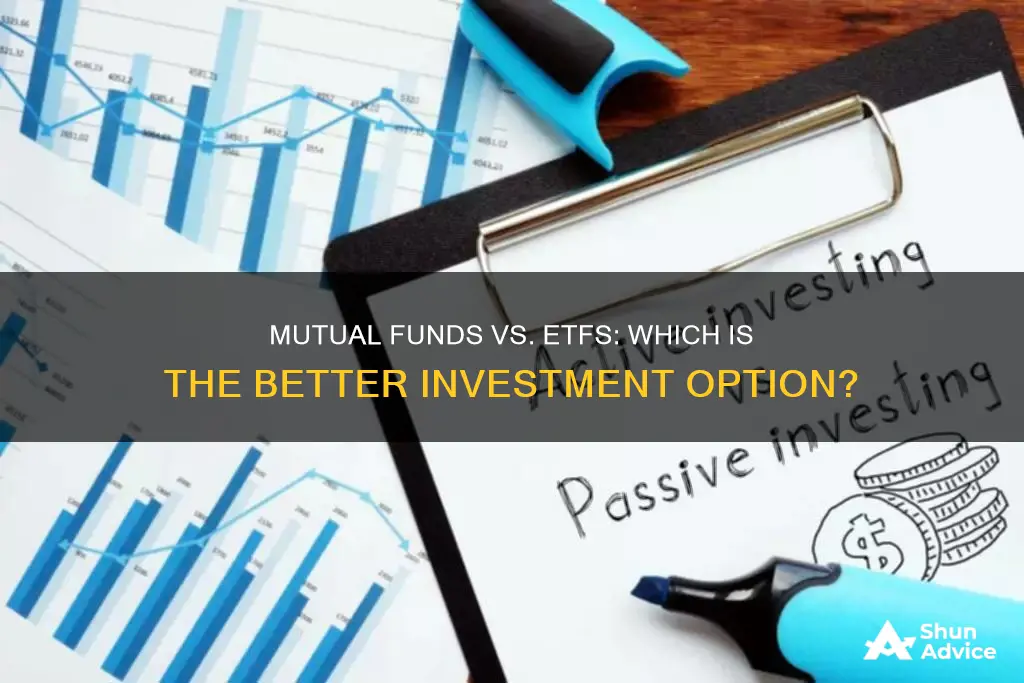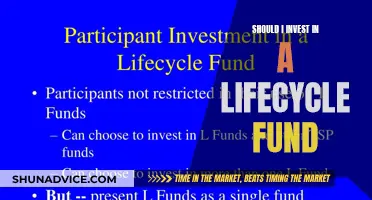
Exchange-traded funds (ETFs) and mutual funds are both professionally managed collections or baskets of individual stocks or bonds. They both adhere to the same regulations and can be good options for investors. However, there are some key differences between the two that make one better suited than the other concerning an investor's investment goals.
ETFs are traded on stock exchanges and can be bought and sold throughout the day at market prices, similar to stocks. They tend to be passively managed, meaning their holdings track a preset index of securities. They usually charge low expenses and have no sales commissions. ETFs also offer tax advantages, low commissions, and easy tradability.
On the other hand, mutual funds are commonly managed by financial institutions and can be purchased only after the market is closed when their net asset value (NAV) is calculated and set. They often have higher expense ratios and may charge sales commissions. Mutual funds can offer active management and greater regulatory oversight, but at a higher cost.
| Characteristics | Values |
|---|---|
| Trading characteristics | Mutual funds are bought and sold at the end of the trading day, whereas ETFs are traded throughout the day like ordinary stocks. |
| Pricing factors | Mutual funds are priced at the net asset value (NAV) of the fund, calculated after the market closes. ETFs are priced at the current market price, which can fluctuate throughout the day. |
| Tax implications | Mutual funds may generate more capital gains taxes due to frequent buying and selling within actively managed funds. ETFs are generally more tax-efficient due to their structure and typically lower turnover of portfolio assets. |
| Investment minimums | Mutual funds often have minimum investment requirements, ranging from a few hundred to thousands of dollars. ETFs do not have minimum investment requirements beyond the price of one share. |
| Management style | Mutual funds can be actively or passively managed. ETFs typically track an index and are generally passively managed, although there are actively managed ETFs. |
| Expense ratios and fees | Mutual funds often have higher expense ratios due to potential active management. They may also carry sales loads or other charges. ETFs usually have lower expense ratios, especially if they are passively managed. |
| Regulatory oversight | Mutual funds can offer greater regulatory oversight at a higher cost. |
| Transaction frequency | Mutual funds only allow transactions once daily. ETFs can be bought and sold at any point during a trading session. |
What You'll Learn
- Mutual funds are bought directly from investment companies, whereas ETFs are bought and sold on a stock exchange
- ETFs are more tax-efficient than mutual funds
- ETFs are generally passively managed, whereas mutual funds are actively managed
- Mutual funds have higher minimum initial investments than ETFs
- ETFs are more flexible than mutual funds

Mutual funds are bought directly from investment companies, whereas ETFs are bought and sold on a stock exchange
Mutual funds and ETFs (exchange-traded funds) are similar in that they are both professionally managed collections or "baskets" of individual stocks or bonds. However, they are bought and sold differently. Mutual funds are generally bought directly from investment companies, whereas ETFs are bought and sold on a stock exchange.
Mutual funds are bought and sold directly from the mutual fund company. Investors contact the company and tell them they want to acquire or redeem shares. Orders are executed once per day, and anyone who invests on the same day receives the same price. Mutual funds are priced only at the end of each trading day, based on the net asset value (NAV) of the underlying portfolio. The NAV is derived by dividing the total value of the securities in the portfolio by the number of shares outstanding.
In contrast, ETFs are bought and sold on a stock exchange, and their price fluctuates throughout the day according to supply and demand. ETFs trade like stocks, and their price changes throughout the trading day. This means that the price at which you buy an ETF will likely differ from the prices paid by other investors.
The different buying and selling processes of mutual funds and ETFs have several implications for investors. For example, mutual funds can be bought with a minimum initial investment, which is a flat dollar amount, whereas ETFs can be bought for the price of one share. Mutual funds allow for automatic investments and withdrawals, whereas ETFs do not. Mutual funds are also more suitable for investors who want to keep things simple, as ETFs allow for more sophisticated order types that give investors more control over the price.
Another difference is that mutual funds require a significant part of their portfolios to be held in cash to satisfy share redemptions each day, whereas ETFs do not have this requirement. This means that mutual funds have a "cash drag," where a portion of the portfolio earns no return.
Finally, mutual funds are often considered more suitable for long-term investors, as they can only be bought and sold once per day, whereas ETFs can be traded anytime during market hours, offering more liquidity and flexibility.
Vanguard Funds: Best Investment Options for Now
You may want to see also

ETFs are more tax-efficient than mutual funds
Exchange-traded funds (ETFs) are considered more tax-efficient than mutual funds. This is due to their structure and how they are managed.
Firstly, ETFs have a unique mechanism for buying and selling. They use "creation units" that allow for the collective purchase and sale of assets in the fund. This means that ETFs usually don't generate the capital gains distributions that mutual funds do and, therefore, don't see the tax effects of those distributions.
Secondly, most ETFs are passively managed. This means that the portfolio only changes when there are changes to the underlying index it replicates, which creates fewer transactions. Actively managed mutual funds, on the other hand, experience taxable events when selling the assets within them.
ETFs that hold dividend-paying stocks will ultimately distribute earnings to shareholders, and dividend-focused ETFs may do so more frequently. However, qualified dividends may be taxed at lower capital gains rates if certain conditions are met.
Mutual fund managers must constantly rebalance the fund by selling securities to accommodate shareholder redemptions or to reallocate assets. The sale of securities within the mutual fund portfolio creates capital gains for the shareholders, even for those who may have an unrealized loss on the overall mutual fund investment.
ETFs are also more transparent than mutual funds, with holdings disclosed regularly and frequently, whereas mutual funds are only required to disclose their holdings quarterly. This additional transparency means investors know exactly what they are investing in and where their money is going.
Overall, ETFs are considered more tax-efficient than mutual funds due to their unique structure and passive management, which results in fewer taxable events and, therefore, lower tax liabilities for investors.
Index Funds: Utopia or Dystopia for Investors?
You may want to see also

ETFs are generally passively managed, whereas mutual funds are actively managed
Exchange-traded funds (ETFs) and mutual funds are both "managed baskets" of individual securities that can offer exposure to a wide variety of asset classes, including stocks and bonds. However, a key difference lies in their management style, with ETFs generally being passively managed and mutual funds actively managed.
Passive management refers to a style of fund management where the fund's portfolio mirrors a market index. In other words, passively managed funds, such as ETFs, aim to replicate the performance of a specific index rather than trying to outperform it. This means that the fund's holdings will closely follow the index it tracks, and changes are only made when the index itself adds or removes constituents. Passive funds generally don't "beat" the market because their goal is to faithfully replicate its performance. ETFs that follow this strategy are often referred to as index funds.
On the other hand, actively managed funds, like most mutual funds, involve fund managers who actively buy and sell securities in an attempt to outperform an index benchmark. These fund managers, possibly backed by a team of research analysts, select and manage the assets in their fund with the goal of beating their chosen benchmark. This could involve delivering higher returns or, in rough markets, selling more speculative assets and adding more conservative investments.
The passive management style of ETFs often leads to lower fees for investors. Since passively managed funds are simply mirroring an index, they require less active decision-making and trading, resulting in lower management fees. In contrast, the active management of mutual funds involves more research, trading, and security selection, leading to higher management expenses.
It's important to note that while most ETFs are passively managed, there are actively managed ETFs as well. These funds involve fund managers who actively trade securities within the ETF to try to outperform an index. However, such actively managed ETFs are not as common as their passively managed counterparts.
In summary, the management style of ETFs and mutual funds differs, with ETFs typically being passively managed and mutual funds actively managed. This distinction has implications for the funds' trading behaviour, costs, and performance expectations.
Understanding Passive Index Funds and Their Investment Types
You may want to see also

Mutual funds have higher minimum initial investments than ETFs
When it comes to minimum initial investments, mutual funds and ETFs differ significantly. ETFs, as exchange-traded funds, are traded on exchanges in the same way as stocks. They can be purchased for the price of a single share, which is typically referred to as the ETF's market price. This price could be as little as $50 or a few hundred dollars, depending on the ETF. On the other hand, mutual funds have minimum initial investments that are set as a flat dollar amount and are not based on the fund's share price. For example, most Vanguard mutual funds have a $3,000 minimum, which would buy you 30 shares of a hypothetical fund with a net asset value (NAV) of $100 per share. This difference in minimum initial investment requirements makes ETFs more accessible to investors with smaller amounts of capital, as they can invest in ETFs even if they cannot meet the minimum investment requirements of mutual funds.
The ability to buy fractional shares of ETFs is another factor that contributes to their lower minimum initial investment. While some brokers may not allow the purchase of fractional shares, many modern brokerage platforms offer this option. This means that investors can purchase an ETF for less than the cost of a full share, further reducing the barrier to entry. In contrast, mutual funds typically do not offer the option to buy fractional shares, making the minimum initial investment a significant consideration for potential investors.
The difference in minimum initial investments between mutual funds and ETFs is also influenced by the way they are traded. ETFs are traded on stock exchanges throughout the day, allowing investors to buy or sell at any time during the trading session. This flexibility enables investors to take advantage of market opportunities as they arise and make smaller, more frequent investments if desired. Mutual funds, on the other hand, are typically bought directly from investment companies and are traded only once per day after the market closes. This means that investors must accumulate enough capital to meet the minimum initial investment requirements of mutual funds and cannot take advantage of intraday price fluctuations for buying or selling.
The higher minimum initial investments of mutual funds are often justified by the fact that they offer active management and greater regulatory oversight. Actively managed funds incur higher costs due to expenses such as analysts, economic and industry research, company visits, and administration. These costs are passed on to investors in the form of higher fees and expenses. In contrast, ETFs, which are typically passively managed, have lower expenses since they aim to track an index rather than actively select investments.
In summary, mutual funds and ETFs differ significantly in terms of minimum initial investments. ETFs offer lower barriers to entry by allowing investors to purchase a single share or even fractional shares, while mutual funds often require a flat dollar amount that can range from a few hundred to thousands of dollars. The ability to trade ETFs throughout the day and the passive management approach of most ETFs contribute to their lower minimum initial investments. The higher minimum initial investments of mutual funds are justified by the active management and regulatory oversight they provide, resulting in higher costs that are passed on to investors.
Mutual Funds in the Philippines: Best Places to Invest
You may want to see also

ETFs are more flexible than mutual funds
Exchange-traded funds (ETFs) are more flexible than mutual funds. They can be bought and sold at any time during the trading day, whereas mutual funds can only be bought or sold once per day, after the close of trading. This means that investors can get out of an ETF at any time, but with a mutual fund, they would have to wait until the end of the trading day, which could be costly.
ETFs are traded like stocks, so investors can do things like writing options against them, shorting them, and buying them on margin. Mutual funds, on the other hand, are bought directly from investment companies and do not offer the same versatility.
ETFs also offer more hands-on control over the price of your trade. They provide real-time pricing and allow for more sophisticated order types that give you greater control over your price. With a mutual fund, you get the same price as everyone else who bought and sold that day, calculated after the trading day is over.
ETFs have a lower investment minimum than mutual funds. You can buy an ETF for the price of a single share, whereas mutual funds have a minimum initial investment of a few hundred or thousand dollars.
ETFs are also more flexible when it comes to taxes. They are more tax-efficient than mutual funds because they are passively managed and don't change their holdings as often. ETFs also have a structural ability, called the in-kind creation/redemption mechanism, to minimize the capital gains they distribute. Mutual funds, on the other hand, may trigger capital gains taxes for shareholders even if their investment is down from when they first bought it.
Finally, ETFs offer more flexibility in terms of automatic investments and withdrawals. With mutual funds, you can set up automatic investments and withdrawals based on your preferences, but this is not possible with ETFs.
The Right Time to Invest in Index Funds
You may want to see also
Frequently asked questions
Mutual funds are bought and sold at the end of the trading day and are often actively managed. ETFs are traded on exchanges like stocks and are usually passively managed. ETFs also tend to be more cost-effective and liquid.
Yes, investors in mutual funds and ETFs are taxed based on the gains and losses incurred within the portfolios. ETFs generally have lower expense ratios than mutual funds, which can result in tax advantages.
Yes, mutual funds often have minimum initial investment requirements, while ETFs can be purchased for the price of a single share.
Yes, mutual funds and ETFs can live side by side in a portfolio. The choice depends on your investment goals and preferences.
It depends. Mutual funds and ETFs can both offer exposure to a wide variety of assets, such as stocks, bonds, and commodities. However, ETFs may be more suitable for certain niche investments due to their flexibility and trading characteristics.







